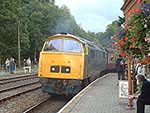| |
For
some years I had travelled regularly on one of the two southbound
services which left Shrewsbury mid morning, either the Liverpool to
Plymouth, usually a Castle working, but more often the Manchester to
Swansea, which was a Midland working through to Pontypool Road, usually
a Jubilee or Royal Scot. And
so I waited at Shrewsbury on 21st April 1962, to see what was on the
first of the two trains. In came the Liverpool to Plymouth behind 71000
Duke of Gloucester. Now that would have been worthwhile for a trip to
Ponty. But sadly it came off, but instead of the usual 83A or 84G
Castle, down backed D825 Intrepid. I cannot say that I was impressed,
but I joined the train for my first Hydraulic run (see below). It was
over a year later that I got my second Hydraulic run, an afternoon
journey from Paddington to Birmingham behind D1019 Western Challenger.
Although I had seen a few "Westerns" at Birmingham Snow Hill,
and had grudgingly accepted that their appearance and sounds were ok, I
was about to find out what a Western really sounded like. Magnificent. I
was hooked, and me a pure "Steam man". I would go quite often
to Reading for a day's trainspotting, but in truth it was to hear the
Westerns pulling away and accelerating. I only managed 3 trips on the
Paddington to Birmingham route before it was decided to concentrate the
Westerns on the Bristol, South Wales, and West of England lines, and
Brush Type 4's took over most of the Birminghams.
In
1964, still pretending to be a "Steam man", I got plenty of
running during a week with a "Western Region Railrover".
Meanwhile I had also discovered the Hymeks, another diesel class whose
sounds enthralled me.
|
|


